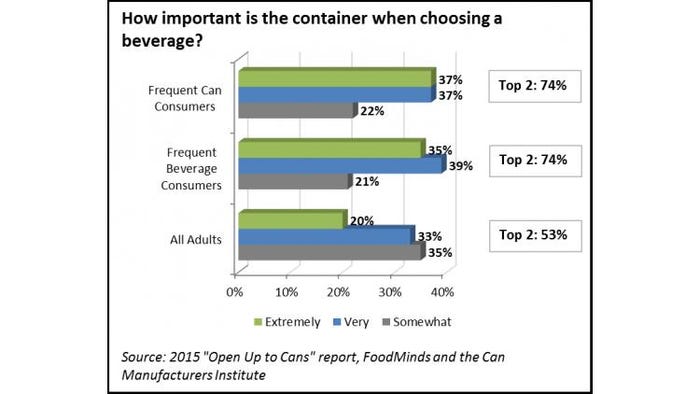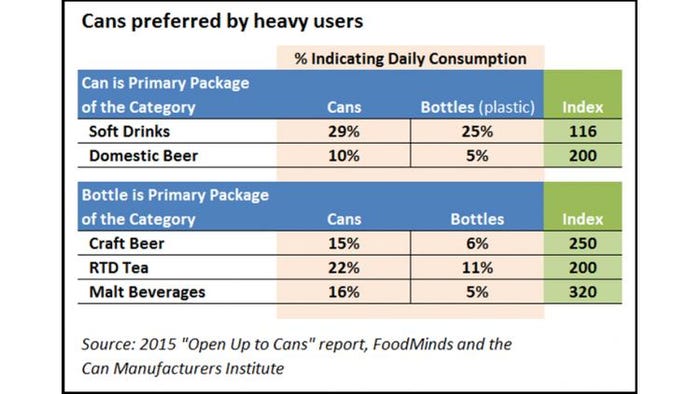Beverages in cans encourage more frequent consumption
Want to sell more beverages? Perhaps you should consider packaging them in aluminum cans. New research shows that frequent users tend to consume even more when the beverage is in a can, as compared to bottles.
The study was conducted by FoodMinds, a Chicago-based food and nutrition consulting company, on behalf of the Can Manufacturers Institute (CMI). Results from this extensive consumer research—along with other retailer and brand owner research—help support CMI’s newest business-to-business promotional campaign for beverages, “Open Up to Cans,” which focuses on four core beverage can performance benefits: product taste and integrity, innovation, performance and sustainability.
Robert Budway, CMI president, explains, “Open Up to Cans promotes the benefits that matter to consumers and brand owners alike. The campaign will serve as an educational platform for beverage brands and packaging companies to access research proof points to show why the can is the package of choice across multiple beverage categories.”
The research, which includes both qualitative and quantitative data, asked about the role the packaging plays in the choice of beverage. For All Adults, 53% say it is Very or Extremely important. When filtering the results for Frequent Beverage Consumers and for Frequent Can Consumers, these Top 2 results jumps to 74%.

When delving into this area of frequent consumption, the study reveals that in categories where cans dominate (that is, where cans are the primary package for the category), cans tend to be consumed more frequently by frequent users. That seems logical.
But the results also show that, even in categories where cans are not the dominant package—such as craft beer, ready-to-drink tea and malt beverages—cans are still preferred by people who say they frequently consume that product.
Grant Prentice, director of strategic insights, FoodMinds, explains, “When you look at the people who are saying ‘That’s a form that I use on a regular basis or almost on a daily basis,’ it’s much more likely to be a can than a bottle for those particular categories. So you’ve got a much higher index for cans, relative to bottles, among those heavier consumers.”

Why does the container make such a difference?
Prentice says there are several reasons. “There are elements of the sensory experience that makes drinking out of cans more pleasurable. It’s also a very convenient package. It’s easy to stack; quick to cool,” he says. “There are some other ‘use’ aspects about it that facilitate that more-frequent consumption as well—the functionality. And cost, too. From a price-point, there’s probably some role being played there.”
Among the results of the quantitative research are:
• A little more than two-thirds of respondents (69%) agree with the statement “Relative to a plastic bottle, a chilled can of my favorite beverage feels colder and more refreshing.”
• When it comes to product protection, 85% of survey takers agree with this statement: “Cans effectively block out damaging efforts of light, and help preserve flavor and carbonation.”
Prentice expounds, “What we’ve heard from manufacturers, particularly in the craft beer segment, is that they look at that as a way of protecting and preserving that amber nectar that they’ve brewed…from a carbonation and taste perspective, and from being light struck, which has a detrimental effect on beer. That’s something consumers understand as well.”
• Additionally, 67% say they prefer cans because they are harder to damage than other packages and are easier to carry.
• Convenience enters in, too, for busy Americans, as 68% say they prefer cans because they are easy to grab on the go.
The takeaway? Prentice says, “Even if you are a beverage manufacturer that felt glass was important—or aseptic packaging or any other forms were important to your product—you would want to have cans in the mix.”
His advice continues, “Look at it by channel. You’re going to have packages that go across different channels. In those channels where your heavier consumer is shopping and purchasing, you should have a can option—because your customers lean that way anyway in the way they consume.”
While this research only looked at the primary package, the carrying and dispensing convenience of the secondary packages—such as dispensing cartons, aka Fridge Packs, especially for beer and soft drinks—could be part of the reason why cans are preferred.
About the Author(s)
You May Also Like




